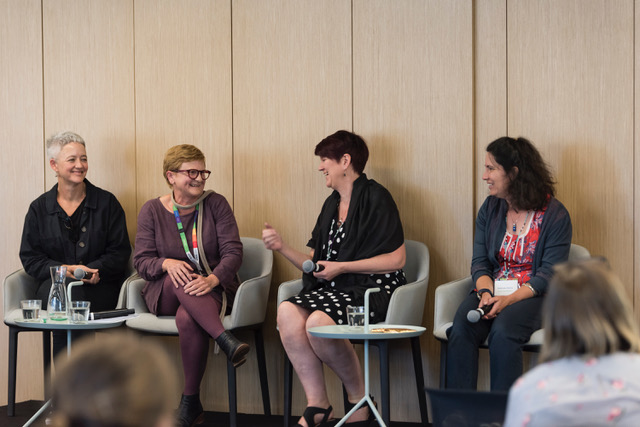I am pleased to report the success of the ‘Managing Risks to Collections’ conference in Melbourne, jointly presented by the Preventive Conservation SIG and the Sustainable Collections Committee. The conference was attended across the three days by close to 120 delegates from every state in Australia and international delegates and speakers from the Philippines, Singapore, Japan, New Zealand, the UK and USA.
 The theme of the conference was the ten agents of deterioration and these were explored, dissected, and discussed through keynote speakers, lightning talks, posters and some engaging and lively panel discussions. Plus, many conversations continued over into the various breaks including the welcome reception and dinner.
The theme of the conference was the ten agents of deterioration and these were explored, dissected, and discussed through keynote speakers, lightning talks, posters and some engaging and lively panel discussions. Plus, many conversations continued over into the various breaks including the welcome reception and dinner.

Delegates had many opportunities to engage with colleagues, make new connections and catch up with old friends. The format of the conference pulled the speakers from each session together before each break for question time. This allowed for each theme to be discussed with questions to the speakers and created more dialogue around each theme.
In developing the program for the conference, the organising committee was keen to ensure that the conference provided a solid platform for conservators, registrars, collections managers and other museum professionals to build on current knowledge and share developing research into this broad topic. Therefore, the conference began with keynote speaker Jane Henderson (Cardiff University) guiding us through how we got to the ‘risk assessment’ phase of preventive conservation and Alice Cannon and Vicki Humphrey followed with risk applications in institutions. The first day continued with the key speakers from the conservation profession and industry experts in climate and lighting. Day two began with the keynote from Dr Joel Taylor (Getty Conservation Institute) who outlined environmental parameters and expanded upon the ASHRAE chapter. This was followed by case studies and projects within the theme of incorrect temperature and relative humidity. A panel discussion followed the ratification of the AICCM Environmental Guidelines and Amanda Pagliarino’s paper outlining the process of establishing these guidelines.
The final day had a major focus on dissociation, presented from many angles, such as contemporary art, time-based media, digitisation, cultural context and connections and legal parameters. Dissociation as a risk was a prominent theme in the papers submitted and solicited for the conference and therefore this theme was allocated additional time to fully realise this relevant topic.

I have shared some of the comments from the survey conducted on the last day of the conference. I have included two of the questions below. The overall response from the survey was exceptionally positive, with the majority of delegates rating speakers, themes, venue, and catering as excellent. And the majority are highly likely to return for the next conference and recommend our conference to colleagues.

Questions from survey
In your opinion, did the conference meet its objective of providing insights into current approaches to managing risk to collections?
- Definitely — as a collection manager / registrar I wasn’t sure how relevant it would be, but it was fantastic and answered so much!
- Yes. Covered a broad spectrum of the current issues, ranging from the technical to more practical applications.
- Yes. Great variety of perspectives from all shapes and sizes of organisations. Synergies in unexpected places.
- Yes. As an emerging conservator the topics covered and the engagement with the speakers was excellent.
- Yes, I liked the honesty of presenters and applicability of examples and case studies.
- Yes, it was inspiring hearing peoples honest assessments and opinions. Enjoyed the panel discussion at the end of each session
- It did. I especially liked how the themes were determined. It was interesting to see the recurring themes e.g. Don Rumsfeld, communication throughout the sessions.
- Speakers from various fields/departments not just conservators gave a broader perspective.
- The insights into current approaches of managing risks were fantastic. The range of topics covered was excellent, and the generally collegiate and open (at times incredibly frank and honest) sharing of experiences and ensuring discussion was refreshing. More please!
What topic or theme would you like to see at the future conferences?
- More disaster planning and response—mentioned several times
- Risks involved with making collections available on line
- Technology collections
- Modern approaches to object housing/storage
- Inherent vice!
- Natural science collections
- Preventive conservation as part of strategic planning
- Progress – from here
- Positives from the regions – the stuff they do better/cheaper/easier than the Big.
- Sustainability, plastics, funding and communication in conservation, relocating collections and dealing with building works/redevelopments.
If you would like the opportunity to contribute your thoughts to the survey please click here.
Thank you to all who presented, attended and responded to the survey. It was a fantastic conference and as the Preventive SIG Convenor I congratulate all who participated. I am (we are — committee included) looking to hold the next conference in two years time. So we hope to see you there.